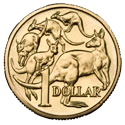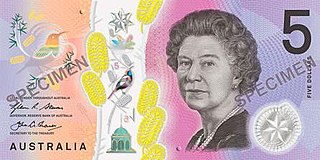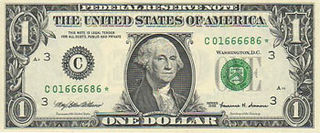
The Australian dollar is the currency of Australia, and of three independent Pacific Island states, specifically Kiribati, Nauru, and Tuvalu. It was introduced on 14 February 1966 when the pre-decimal Australian pound, with subunits of shillings and pence, was replaced by the new decimal currency, the Australian dollar.

A banknote is a type of negotiable promissory note, made by a bank, payable to the bearer on demand. Banknotes were originally issued by commercial banks, which were legally required to redeem the notes for legal tender when presented to the chief cashier of the originating bank. These commercial banknotes only traded at face value in the market served by the issuing bank. Commercial banknotes have primarily been replaced by national banknotes issued by central banks.

Sterling banknotes are the banknotes in circulation in the United Kingdom and its related territories, denominated in pounds sterling.

The córdoba is the currency of Nicaragua. It is divided into 100 centavos.
Notaphily is the study and collection of paper currency, and banknotes. A notaphilist is a collector of banknotes or paper money, particularly as a hobby.

The kina is the currency of Papua New Guinea. It is divided into 100 toea. The kina was introduced on 19 April 1975, and circulated along with the Australian dollar until 1 January 1976, when the dollar ceased to be legal tender.
Polymer banknotes are banknotes made from a polymer such as biaxially oriented polypropylene (BOPP). Such notes incorporate many security features not available in paper banknotes, including the use of metameric inks. Polymer banknotes last significantly longer than paper notes, causing a decrease in environmental impact and a reduced cost of production and replacement.

The dirham is the currency of Morocco. It is issued by the Bank Al-Maghrib, the central bank of Morocco. It is subdivided into 100 centimes.
Banknotes have been issued for use specifically in Northern Ireland since 1929, and are denominated in pounds sterling. They are legal currency, but technically not legal tender anywhere. However, the banknotes are still widely accepted as currency by larger merchants and institutions elsewhere in the United Kingdom. Issuing banks have been granted legal rights to issue currency, and back the notes with deposits at the Bank of England.
Note Printing Australia (NPA) is a wholly owned subsidiary of the Reserve Bank of Australia (RBA) that produces banknotes and passports. It was corporatised in July 1998 and is located in Craigieburn, Melbourne. NPA has its origins as a subsidiary of the Commonwealth Bank and was established in 1913 to print banknotes for Australia. After printing paper banknotes for 75 years, NPA introduced the first polymer banknote technology in 1988. NPA print banknotes for several other countries as well as Australia due to the high standards of durability and difficulty of counterfeiting.

The Australian twenty-dollar note was issued when the currency was changed from the Australian pound to the Australian dollar on 14 February 1966. It replaced the £10 note which had similar orange colouration. There have been only two different issues of this denomination: a paper note which had a gradient of yellow and red, with a distinct orange background, and a polymer note which can be recognised for its distinct red-orange colouration. The polymer note was issued on 31 October 1994.

The Australian ten-dollar note was issued when the currency was changed from the Australian pound to the Australian dollar on 14 February 1966; it replaced the £5 note which included the same blue colouration. There have been four different issues of this denomination, a paper banknote, a commemorative hipolymer note to celebrate the bicentennial of Australian settlement, the 1993-2017 polymer note, and from September 2017 a polymer note featuring a transparent window.

The Australian one hundred-dollar note was first issued in 1984 as a paper note. There have been two different issues of this denomination: initially a very light turquoise-blue paper note, and from May 1996, a green polymer note.

The Australian five-dollar note was first issued on 29 May 1967, fifteen months after the currency was changed from the Australian pound to the Australian dollar on 14 February 1966. It was a new denomination with mauve colouration – the pound system had no £2½ note.
The banknotes of the Australian dollar were first issued by the Reserve Bank of Australia on 14 February 1966, when Australia adopted decimal currency. This currency was a lot easier for calculating cost rather than the British, Pound, Shilling and Pence system. The $5 note was not issued until May 1967.

A replacement banknote, commonly referred to as a star note, is a banknote that is printed to replace a faulty one and is used as a control mechanism for governments or monetary authorities to know the exact number of banknotes being printed. Also, since no two serial numbers can be the same, the bill is simply reprinted with a symbol in the serial number, identifying it as a replacement for an error note. Replacement bills have different symbols to mark the error around the world, although the most popular examples are "star notes".

The Frontier Series is the seventh series of banknotes of the Canadian dollar released by the Bank of Canada. The polymer banknotes were designed to increase durability and to incorporate more security features over the preceding Canadian Journey Series. The notes feature images that focus on historic Canadian achievements and innovation. It is the first banknote series issued by the Bank of Canada printed on a material other than paper.

Danske Bank UK is a commercial bank in Northern Ireland. Northern Bank was one of the oldest banks in Ireland having been formed in 1809, and formed part of one of the Big Four banks in Ireland. Northern Bank took on the name of its parent company Danske Bank as its trading name in November 2012. The bank is considered one of the leading retail banks in Northern Ireland with 44 branches and 3 finance centres. Danske Bank is one of the four commercial banks in Northern Ireland which are permitted to issue their own banknotes.
Guardian is the trademark name of a polymer originally manufactured by Securency International, a joint venture between the Reserve Bank of Australia and Innovia Films Ltd. The latter completed acquisition of the former's stake in 2013.

The Royal Bank of Scotland £5 note, also known as a fiver, is a banknote of the pound sterling. It is the second smallest denomination of banknote issued by The Royal Bank of Scotland. The current polymer note, first issued in 2016, bears an image of the author Nan Shepherd on the obverse and a pair of mackerel on the reverse.
















